Perfectly Cooked Filet Mignon Prepared Two Ways
It is undeniable that the most tender, buttery, luscious steak on a cow is the filet. If you’re celebrating, chances are good you’re celebrating with filet! But how should you prepare it? Here we take a look at a couple of options so you can figure out your favorite.
Filet Mignon: A Tender Favorite
It comes from the tenderloin—the least worked muscle of the animal, so it’s the least tough. This ultra tender cut of meat is also very lean. There isn’t very much fat to add to its flavor and mouth-feel in the final product. Care has to be taken to prepare the meat to optimize the cut’s texture.
What Makes a Great Filet Mignon?
The perfect filet mignon will have a tender, juicy interior with a flavorful, crisp exterior. While complementary to the taste, these are actually two very different objectives and each will each take its own careful preparation to achieve.
A Tender, Juicy Interior
We’ll start with the interior of the meat. Most connoisseurs of the almighty filet mignon would agree that it’s sacrilege to let the meat cook beyond medium rare (130°F [54°C]). That’s because, if it’s cooked much further, this cut loses its buttery texture.
Filet Mignon Temperature Tip: Aim for an internal temperature of 130-135ºF, after resting, for medium-rare.
Remember, there isn’t much fat in the lean filet. Higher heat quickly denatures the protein strands, making them tough and chewy. So we will take extra care in monitoring the internal temperature of our filet mignon! We’ll also want to cook the interior of the meat slowly, to achieve uniformity of texture and taste. Convection—the transfer of heat through the air—will be gentle enough to bring the center of the meat to the perfect doneness without overcooking the layers around it. “Low and slow” is the name of this game.
A Crisp Exterior
For the exterior of the meat, however, we want the color and flavor of searing. Conduction—direct contact with a high heat source—will allow the processes of caramelization and the Maillard reaction to occur. Two stages of cooking for the perfect combination of flavors and textures.
Testing
To achieve this one-two-steak-punch, we decided to try two methods:
1. Smoking the steak first (convection) and finishing with a pan sear (conduction)
2. Pan searing first and then finishing in the oven
The initial “raw” preparation for both methods is exactly the same. Each is patted dry and then given a light sprinkling of sea salt.
Filet Mignon Smoked then Pan-seared
Since we are shooting for a specific internal temperature, the ThermoWorks® ChefAlarm® is the perfect tool. We set the alarm to sound when the internal temperature reaches 108°F (42°C)in the smoker and then let it rest to see what the final temperature will be after carryover.
This method works great. We found that the smoked meat increased a full 22 degrees up to 130°F (54°C) while resting—perfect medium rare doneness!
After the meat rests, we bring a sauce pan up to medium-high heat for about 3 minutes before introducing the steak. The steak is pan-seared over medium-high heat for about 2-3 minutes on each side; long enough for caramelization and the maillard reaction to occur—the processes that gives the meat flavor and browning.
Filet Mignon Pan-seared and Finished in the Oven
For our second method, we start with the searing and then bring the interior up to temperature in the oven.
We follow the same method as before, searing the raw steaks for 2–3 minutes on each side in a pre-heated sauce pan. Then the steaks are transferred to a metal baking sheet and placed on the middle rack of a 450°F (232°C)oven. Here again, we use our ChefAlarm thermometer to track the internal temperature of the steak.
In our testing, after we pulled the steak out of the oven once, it reached 120°F (49°C). Carryover cooking increased its temperature to 135°F (57°C).
Interesting! The smoked steak’s temperature went up by 7 degrees more than our pan-seared steak. The smoker’s temperature was lower than the pan, and took longer to reach its lower temperature of 108°F (42°C) but the temperature rise during resting was greater.
You may note that these are dramatic carryover temperature rises. But even on a second test, we saw a full 13°F rise during resting with normal resting conditions (the steaks rested uncovered on a cutting board at room temperature). The traditional wisdom is that you should see a 7 or 8 degree rise during resting, but our testing suggests otherwise with this cut of meat (see note).
Our Results
See for yourself. On the left are the two steaks that were prepared with the pan-sear/oven method, and the right are the two steaks prepared with the smoke/pan-sear method. The smoked steaks on the right have clean, even edges and the muscle fibers are close together and fairly straight. The closer together the muscle fibers are, the more moisture the meat will retain.
The edges of the oven-cooked steaks on the left aren’t as straight and clean, and the muscle fibers are more jagged than straight. They also aren’t as close together.
What happened is that the protein had a chance to set in the smoker before the steak was put in the pan to sear, so it wasn’t initially shocked and shrunken from its raw state. The smoked steak had a noticeable but not-too-strong smokey flavor with a tender and smooth texture. The oven-finished steak was also very good, but the exterior texture was slightly tougher than the smoked one.
Typically, I eat a well-prepared filet mignon with only salt and pepper—why mess with perfection, right? But if you have a sauce that you love, especially one made from scratch, go for it!
The Takeaway
Both two-stage methods work well. The texture of the interior of the meat was tender with both, but the steaks that were smoked first had better flavor and were a bit less tough on the outside. The results represented the filet mignon in all its medium rare glory, thanks to precise temperature monitoring.
Happy Filet Mignon Weekend, carnivores!
**With such a dramatic temperature increase during rest, we had to test this again! We used the pan-seared and oven-finished method for our second test. We used the exact same procedures as we did the first time with the pan-searing. The steak was pulled from the oven at 120º F. The increase in temperature with the carryover cooking peaked at 133º F—another significant jump. We still had the same result we were looking for, a tender juicy steak with a beautifully caramelized outer edge.


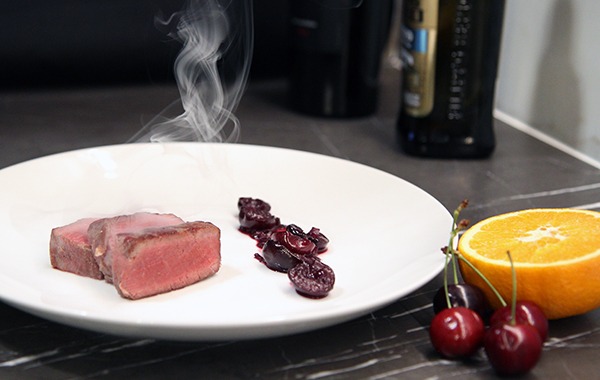
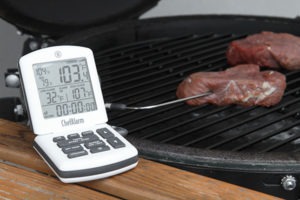
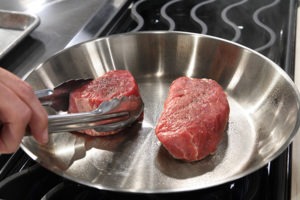
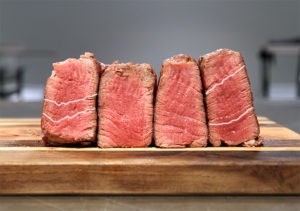
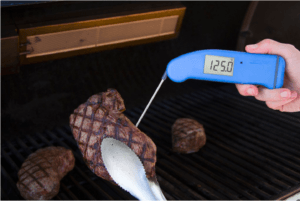

Ruth’s Crist steak restaurants are well known and scattered around the country. Once when eating at the Portland, OR one I asked if I could speak with the chef that did our steaks. Shortly he came to our table and I asked if he might share his method. The answer surprised me but I now use it all the time. They are pre-seard on their grill only on one side. Then placed in a pre-heated skillet (regular type) And then placed in an extremely hot oven. ( 500 degrees ) I asked how long in the oven. He said “I never know.” Then he pulled out of his pocket his Thermapen. He said, “this is the magic.” I now own that one and the alarm one. When people are invited to our house for dinner everyone immediately asks, ” Are we having those steaks again?”
PS… My only seasoning is some olive oil, garlic salt, and a little (large grain) black pepper.
PS, PS…. This site and your information is fantastic.
Dennis, thank you for your comment sharing your story. I have more than a decade of experience as a chef, and I’ve been a chef instructor in a culinary arts degree program. Whenever my students would ask me how long it would take for something to cook or bake I’d always respond, “Until it’s done!” (they would eventually learn to ask the right question). Doneness isn’t always as easy as setting a timer, there are many other factors at play. With meat, accurate internal temperature is the best indicator.
And I couldn’t agree more about the seasoning. If you have a good quality cut of meat prepared well, you don’t want any other flavors to compete with the protein. Salt and pepper is all I need. -Kim
This is a wonderful article and very helpful. However, what recommendations do you have for those of us who do not have a smoker? Do you cook in the oven at a low temperature and then sear? I am particularly interested as I recently cooked filet mignon and was struggling with the traditional directions. I would love to see you follow up on this.
Thanks, Carol
I also start my steaks in the smoker, (at 225F). When it’s time to brown them, I use a hot fire on the grill, but I flip them about once a minute. That slows the heat buildup on the sides, and lessens the thickness of the overcooked layer just under the crisp outside.
Thanks for the tips. I go back and forth between sear first / sear last with similar results.
I am interested in how you smoked the filet. What temp did the smoker reach?
Bob, Our smoker was set to 220F, and turned once after 5 minutes. Thanks! -Kim
Thanks for the tips. I go back and forth between sear first / sear last with similar results.
I am interested in how you smoked the filet. What temp did the smoker reach?
What temperature was the smoker? I used this method recently except I put the filets in a 250 degree oven and took them out at 104 degrees. Our timing was off and I didn’t sear them for about 20 minutes. Tented them with aluminum foil. I seared for 3 minutes on the first side and 2 minutes on the second side. They came out on the rare side but delicious.
Did you use any oil when you did the pan searing??
Joe, yes. I used olive oil on the meat prior to searing. Oiling the meat rather than the pan reduces splatter. Thanks! -Kim
What was the temperature in the smoker?
Michael, the smoker was set to 220 F. Thanks! -Kim
First of all, I love your products (recently ordered another Thermopen).
Please consider providing a wireless thermometer set. There are people like me who do not have an I-phone that can be used with your “BlueTherm Duo”. Instead, serious bbq smokers use the “Maverick” brand. Your Probes, etc. are by far more superior, and people like myself would be willing to spend extra for quality.
Thanks for all you do—–keep up the good work.
Your faithful customer—-John
John, I’m glad to hear you love the products! I appreciate knowing specifics with what we can do to improve–it’s a suggestion we’ve gotten before. We have creative minds working on new ideas here all the time, and we’ll always keep our customers posted with new developments. -Kim
I really enjoyed reading your article. I recently read a similar article in the 2015 Summer Edition of Cottage Life Magazine that also recommeded this “reverse searing” method for cooking steaks. I just ordered a highly recommended ThermoWorks DOT thermometer and I am looking forward to using it to help enhance my BBQ steak results through proper internal temperature control. Ken Mylrea
Ken, you are going to love your DOT! You’ll be amazed at how much easier it’ll make your barbecuing, and you’ll have consistent results each time. -Kim
Kim,
You didn’t specify the temperature of the smoker you used!! You did specify the temperature of the oven!!
As you know, different smokers have a range of temperatures so it’s best to document whatever temperatures you used, especially when comparing two different methods.
Thanks,
Robert
Great tests! I’ve always seared first, then cooked over indirect heat, but I’m definitely going to try reversing that process.
The resting process seems to be very important, and you explained that it should be at room temperature on a cutting board, but for HOW LONG?
I’d appreciate learning what length of time the resting period you used during your tests was, and/or what you recommend that it be for the home cook and novice Thermapen user.
Thanks!
Thank you for your write up. I will be modifying my usual approach with anticipation of a more-perfect fillet.
Please share more specifics on your smoking temperature and process.
You went through a lot of detail, and the results sound amazing. I would like to try the Smoked then Pan-seared routine. However, there are a few key points that you left out.
What was the temperature of the meat when you started?
What was the temperature of the smoker?
How long did you let the meat rest before pan seared it?
I wish you’d have said what temp you ran the smoker at. I use 225 for BBQ. Same for steak? Thx.
Great post!
What temperature did you set the smoker to when you smoked the filet mignon?
Dan, I’d recommend a 5-10 minute rest on your filet. With a larger cut of meat I would recommend 10-20 minutes.
We used a big green egg smoker heated to 220 degrees F and held until the temperature reached 108 degrees F. The filet was flipped after 5 minutes on one side.
We used a big green egg and heated the smoker to 220. Thanks, Chip!
The meat was cold out of the refrigerator, the smoker was set to 220 F (a big green egg), and we took the meat directly from the smoker for the sear. Thank you for the comment and questions, Ed! -Kim
Ken, you are going to love your DOT! You’ll be amazed at how much easier it’ll make your barbecuing, and you’ll have consistent results each time. -Kim
Carol, Yes, you could cook in the oven at a lower temperature first. We smoked the filet at 220 F to an internal temperature of 108 F. We haven’t tested “reverse searing” with oven-roasting first, but I’m sure the results would be similar. Thanks! -Kim
How much did the filets weigh, and what was their thickness?
Great article.
Those filets were big boys–about 6-8 ounces each, and about 1-1/2″ thick.
You mention using the smoker at 220F, but I did not see you specify what wood you used in the smoker. Or were you just using it as an oven?
Bill,
Thank you for your comment. We used hickory to smoke the filet mignon, and it was delicious!
Thanks,
Kim